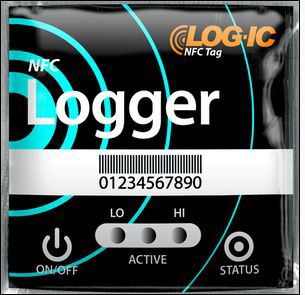American Thermal Instruments (ATI) plans to launch pilots with six global companies in order to test its new RFID-enabled data logger. The testing will enable the firms to record temperatures using a smartphone’s built-in Near Field Communication (NFC) RFID reader, through a product’s box, as the goods are shipped through the supply chain. The six participants, to be selected from the logistics, pharmaceuticals, retail and manufacturing sectors, will employ the new data logger to track vaccines, flowers, fruits, vegetables, wine and other products.
For ATI, the pilots will provide a testing ground for the software and applications that manage data related to each NFC read event. Participants will receive the entire system at no cost, and will be allowed to continue using the technology after the pilots’ completion.
To date, says Matty Toomb, ATI’s VP of sales and marketing, more than six companies seek to pilot the Log-IC NFC data-logger technology. Only six, however, will be approved for participation, based on particular use cases. Toomb has been traveling the world this month, meeting with businesses in Asia and North America, to determine their needs and how the technology would best suit them.
The solution consists of a tag approximately the size of a matchbook, comprising a passive NFC RFID chip combined with a battery-powered temperature sensor and data logger that can store up to 4,000 temperature measurements. For the pilot, ATI is also providing Nexus S NFC-enabled mobile phones, codeveloped by Google and Samsung, with an application to enable the phones to collect temperature data from the logger. The app is available in 11 languages. The system also comes with free software that captures information from the mobile phone, and can then interpret and present that data back to a user in a variety of forms—for example, as a PDF file containing temperature breakdowns, e-mailed to an authorized party, or a dedicated Web page that users can log onto to view their own raw temperature data.
ATI developed the Logi-IC data logger four years ago, in order to collect temperatures and store them until the device is retrieved from a box of goods and plugged via a USB port into a PC, where the information can then be uploaded. That system’s shortcomings, the company reports, are that it requires the logger to be removed from the box before it can be interrogated, and that each time it is read, the data is permanently extracted from the logger. In addition, ATI is developing a temperature data logger integrated with a proprietary active high-frequency (HF) 13.56 MHz RFID tag built into the device (see ATI Partners to Deliver Passive RFID Sensor).
The tag that will be used for the pilot, on the other hand, combines a passive NFC tag and a battery-powered data logger that performs temperature readings at preset time intervals. With such a tag, an NFC reader could simply be placed on the outside of a box to capture the data. In that way, readings can be taken more often and faster, throughout the supply chain. What’s more, reading the tag data does not erase temperature information from the tag. As such, multiple parties could read the data, such as at the point of shipping, at a DC, at a store’s loading dock, or at a hospital or doctor’s office.However, the company prefers to leverage NFC-enabled phones, which it predicts will become available in large numbers next year. “We’re really not interested in being in the reader business,” Toomb says. “We want to sell the data loggers.” In fact, he adds, once ATI makes the system commercially available, the data loggers will be the only piece of the solution that customers will need to pay for. Although pricing plans may change, the company currently intends to provide software and the mobile phone app at no charge. Toomb says his company opted to focus on a solution that will utilize NFC phones rather than standalone RFID readers (handheld or fixed), based on the assumption that NFC phones will be much more prevalent than standalone readers during the coming years.
With NFC, data-logging tags can read be through a box (according to Toomb, the read range is up to 6 inches). The phone, as instructed by the application, then forwards that information to the cloud-based server, hosted by ATI
Pricing for the NFC data loggers consists of two options: Users can either purchase the devices outright—the more common choice, Toomb says—or lease them from ATI. In the latter case, companies are provided with mailing sleeves into which the used loggers can be placed once a product shipment has been completed. A business can mail a used logger back to ATI, which will then retrieve its data and upload it to the cloud-based server, erase the logger’s memory and return the device to the customer for reuse. This mail-in option has been used by customers utilizing the non-NFC-enabled data loggers, who gain from having ATI extract the information for them, freeing their staff of the task upon completion of a shipment. With the NFC-enabled solution, however, customers might be more inclined to retrieve the data themselves, since the process is simpler.
Each of the six trials beginning this fall will be unique, Toomb says, in order to meet the needs of each particular customer. Typically, a participant may use several mobile phones at multiple locations at which the products change hands, such as at a distribution center or hospital. Each customer will then work with ATI to determine the best method for accessing the read data. Upon reading a data logger, an employee would simply wave the mobile phone near the box until obtaining a read of the unique ID number on that logger via the phone. Once that read connection occurs, the temperature data automatically transmits to the mobile phone, which then sends the information via its cellular connection to the ATI server.
The pilots’ focus will be to determine how well end users are able to gain the temperature data they require via ATI’s software and server. The project is also intended to test the firm’s mobile phone app, Toomb says. After the three-month pilots are completed, he notes, the company intends to market the solution commercially, initially charging only for the data loggers. Next year, ATI also plans to sell Bluetooth-enabled data loggers, in order to lengthen the transmission range for data between the logger and the mobile phone—though the NFC-based version would continue to be sold as well.



